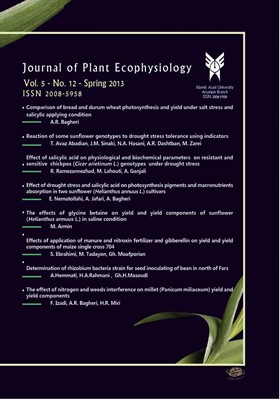-
-
List of Articles
-
Open Access Article
1 - Comparison of bread and durum wheat photosynthesis and yield under salt stress and salicylic applying condition
A.R. Bagheri -
Open Access Article
2 - Reaction of some sunflower genotypes to drought stress tolerance using indicators
T. Avaz Abadian J.M Sinaki N.A. Hasani A.R. Dashtban M. Zarei -
Open Access Article
3 - Effect of salicylic acid on physiological and biochemical parameters on resistant and sensitive chickpea (Cicer arietinum L.) genotypes under drought stress
R. Ramezannezhad M. Lahouti A. Ganjali -
Open Access Article
4 - Effect of drought stress and salicylic acid on photosynthesis pigments and macronutrients absorption in two sunflower (Helianthus annuus L.) cultivars
E. Nematollahi A. Jafari A. Bagheri -
Open Access Article
5 - The effects of glycine betaine on yield and yield components of sunflower(Helianthus annuus L.) in saline condition
M. Armin -
Open Access Article
6 - Effect of application of manure and nitroxin fertilizer and gibberellin on yield and yield components of maize single cross 704
Gh. Moafporian -
Open Access Article
7 - Determination of rhizobium bacteria strain for seed inoculating of bean in north of Fars
A. Hemmati هادی Asadi Rahmani Gh.H. Masoudi -
Open Access Article
8 - The effect of nitrogen and weeds interference on millet (Panicum miliaceum) yield and yield components
F. Izadi A.R. Bagheri H.R. Miri
-
The rights to this website are owned by the Raimag Press Management System.
Copyright © 2021-2025







